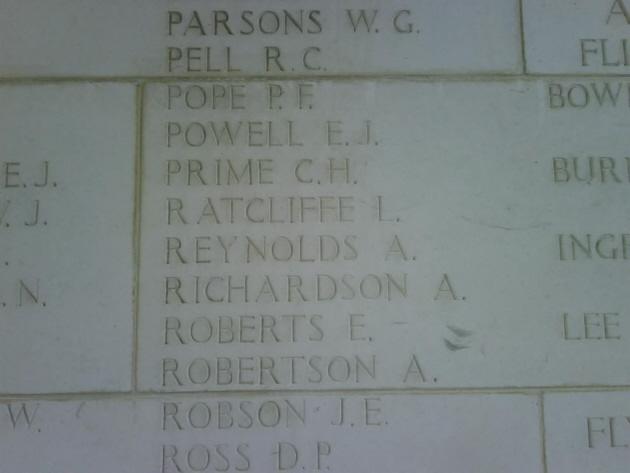Chess Notes
|
| First column | << previous | Archives [57] | next >> | Current column |
6053. Loman column
Fabrizio Zavatarelli (Milan, Italy) has submitted page 6 of De Groene Amsterdammer, 18 August 1889 (chess column by Rudolf Loman):
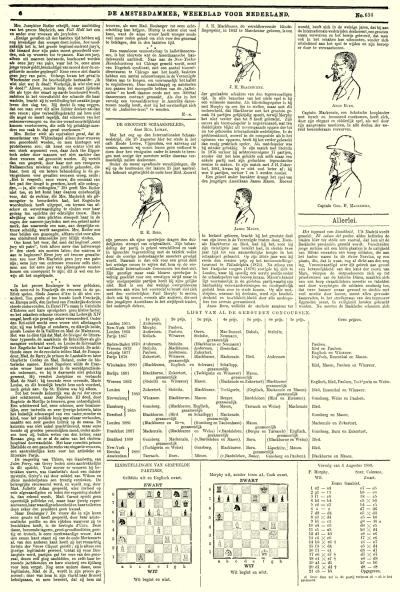
6054. Kolisch games (C.N. 5863)
Regarding the game ‘Turgenev v Kolisch’ given in C.N. 5863 (1 e4 e5 2 Nf3 Nc6 3 Bc4 Nf6 4 Ng5 d5 5 exd5 Na5 6 d3 h6 7 Nf3 e4 8 Qe2 Nxc4 9 dxc4 Bc5 10 Nfd2 O-O 11 h3 e3 12 fxe3 Bxe3 13 Kd1 Re8 14 Qf3 Bxd2 15 Nxd2 c6 16 b3 cxd5 17 Bb2 Ne4 18 c5 Qg5 19 Bc1 Qxg2 20 Rf1 Nc3+ 21 White resigns) Mr Zavatarelli writes:
‘I have found the score on pages 38 and 161 of Memorable Chess Games by W. Moffatt (Stroud, 1913), still without any occasion and with White’s name given as “Jurgenieff”. According to page 547 of Chicco and Porreca’s Dizionario enciclopedico degli scacchi Turgenev wrote in a letter dated 20 January 1860 that he had played against Kolisch on even terms.’
6055. Quote attributed to Staunton
From page 10 of Chess Pieces by N. Knight (London, 1949):

From page 144 of Caissa’s Web by Graeme Harwood (London, 1975):

The passage comes from the first paragraph of an article on pages 189-191 of the 1852 volume of the Chess Player’s Chronicle, but the magazine stated, on page 191, that the article was taken from the West of England Conservative Journal. What grounds could there be for ascribing the text to Staunton?
6056. Terrazas
Regarding Mysteries at Sabadell, 1945 Javier Asturiano Molina (Murcia, Spain) writes:
‘A player named Terrazas (no forename indicated) had played in the Sabadell tournament of 1944, and on pages 265-266 of Ajedrez Español, September 1944 his name appeared in the tournament table, and two of his games were given. The event was called a “Torneo de Maestros”, and there was no mention of Terrazas’ age.’
The two games:
Terrazas – Miguel Albareda Creus
Sabadell, 1944
Queen’s Gambit Declined
1 d4 d5 2 Nf3 e6 3 c4 c6 4 e3 Nf6 5 Nc3 Nbd7 6 a3 Bd6 7 c5 Bc7 8 b4 e5 9 dxe5 Nxe5 10 Be2 O-O 11 Bb2 Qe7 12 h3 Rd8 13 Nd4 Re8 14 Qc2 Bd7 15 Nb1 Ne4 16 Nf3 Bf5 17 Qc1 Rad8 18 Bd4 Nxf3+ 19 Bxf3 Qh4 20 Ra2

20...Nxf2 21 Rxf2 Qxd4 22 Re2 Bg3+ 23 Kf1 Qa1 24 e4 dxe4 25 Bg4 Bxg4 26 hxg4 Qf6+ 27 Kg1 e3 28 Rh3 Qf2+ 29 Kh1 Qxe2 30 Rxg3 Rd1+ 31 White resigns.
Antonio Medina García – Terrazas
Sabadell, 1944
Ruy López
1 e4 e5 2 Nf3 Nc6 3 Bb5 a6 4 Ba4 d6 5 O-O Bd7 6 c4 Nf6 7 Nc3 Be7 8 d3 O-O 9 h3 Qc8 10 Be3 h6 11 Ne2 Nd8 12 Bxd7 Nxd7 13 Ng3 Ne6 14 Nf5 Qd8 15 h4 c5 16 g3 Nd4 17 N3xd4 cxd4 18 Bxh6 gxh6 19 Qg4+ Bg5 20 Nxh6+ Kg7 21 hxg5 Rh8 22 Kg2 Nf8 23 Nf5+ Kg6 24 Rh1 Rh7 25 Rxh7 Resigns.
6057. Ed. Lasker v G. Thomas
The versions of the Lasker v Thomas game-score seem limitless. Frederick S. Rhine (Park Ridge, IL, USA) notes that on page 29 of Chess Techniques by A.R.B. Thomas (London, 1975) the conclusion was given as 16 Be2+ Kg2 17 O-O-O Resigns. As previously noted, many writers have stated that Lasker castled on move 18, but is A.R.B. Thomas alone in suggesting that 17 O-O-O was played?
6058. Ill (C.N. 5890)
Pablo S. Domínguez (Madrid) reverts to the alleged remark by Steinitz, ‘a chess master has no more right to be ill than a general on the battle field’. He notes the following passage, written in the context of the 1896-97 Lasker v Steinitz world championship match, on pages 21-22 of Los campeonatos del mundo. De Steinitz a Alekhine by Pablo Morán (Barcelona, 1974):
‘Esta segunda derrota frente a Lasker fue un duro golpe para Steinitz, pero siempre deportivo, poco después escribía en un diario de Nueva York: “¿Por qué he sido derrotado en forma tan lamentable? En primer lugar, porque Lasker es el más grande jugador que he encontrado; posiblemente el más grande que jamás haya existido. Al afirmar expresamente esto, parecerá que quiero disculparme, rebajando, al mismo tiempo, a otros rivales; pero soy incapaz de hacer tal cosa refiriéndome a maestros de primer orden. Alguna vez he dicho estas o parecidas palabras, que un maestro tiene tan poco derecho a sentirse enfermo en una prueba, como un general en un campo de batalla. Y permanezco fiel a este pensamiento.”’
Our correspondent supplies the following translation:
‘This second defeat against Lasker was a heavy blow for Steinitz, but, always the sportsman, he wrote soon afterwards in a New York newspaper: “Why have I been beaten in such lamentable fashion? Firstly, because Lasker is the greatest player I have met, and possibly the greatest that has ever existed. In stating this expressly, it will seem that I wish to make excuses, while at the same time putting down other rivals, but I am incapable of doing such a thing with regard to first-rate masters. I once said these or similar words: a master has as little right to feel sick in a contest as a general on a battle field. And I remain faithful to that idea.”’
Mr Domínguez comments:
‘It seems likely to me that there is a gap in Pablo Morán’s version of Steinitz’s article, as the closing sentence (“I once said”) does not follow on logically from his previous statements.’
A translation also appeared on pages 15-16 of the 1986 English edition of Morán’s book, The World Chess Championship: Steinitz to Alekhine.
Notwithstanding Morán’s remark about the timing of the statement, we now note that according to page 337 of William Steinitz, Chess Champion by Kurt Landsberger (Jefferson, 1993) it came in a letter from Steinitz dated 17 December 1896 which was published in the New York Sun on 3 January 1897. The relevant sentence, as quoted by Landsberger, is:
‘A chess master has the same right to be sick as a general on the battlefield, this or something similar is that [sic] I had written and I stick to this.’
6059. Advertisement for Stamma book
John Roycroft (London) sends a particularly old specimen of a newspaper advertisement for a chess book: mention of Philip Stamma’s Essai sur le Jeu des Echecs (Paris, 1737) in the London Daily Post and General Advertiser of 10 March 1739:
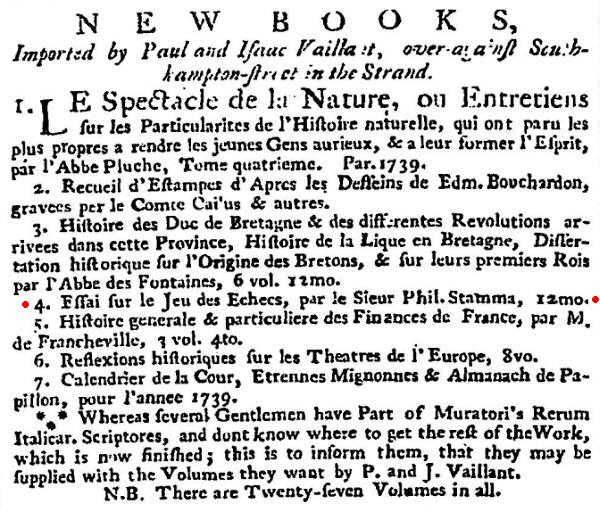
6060. A famous remark
‘There is no other game so esteemed, so profound and so venerable as chess; in the realm of play it stands alone in dignity.’
It is notable how many outlets (e.g. those quantity-first websites) do not bother to give a source when ascribing that remark to Ely Culbertson. Below is the first paragraph of the chess section on page 341 of Culbertson’s Hoyle (New York, 1950), for which Ely Culbertson had as co-authors and editors Albert H. Morehead and Geoffrey Mott-Smith:
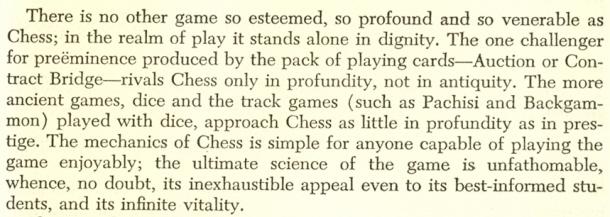
6061. Quote attributed to Staunton (C.N. 6055)
Alan O’Brien (Mitcham, England) notes the curious discrepancies futile/fertile and variety/vanity in the versions reproduced by N. Knight and G. Harwood. It is the latter who went awry. Below is the passage from the West of England Conservative Journal as it appeared on page 189 of the 1852 Chess Player’s Chronicle:
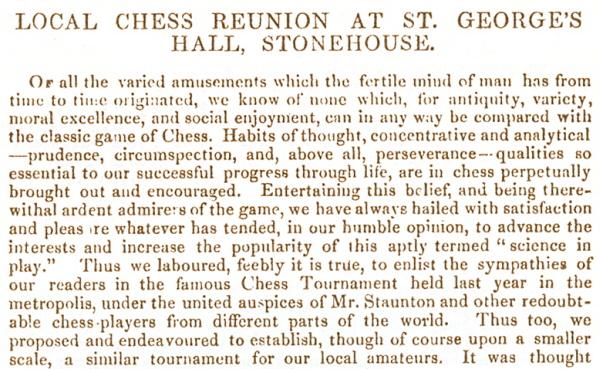
6062. Lasker on the world championship
From page 33 of the November 1905 issue of Lasker’s Chess Magazine (in a signed article by Emanuel Lasker following the Tarrasch v Marshall match):
‘The Doctor [Tarrasch] holds peculiar views on the championship of the world, thinking that the title of champion of the world is an epithet reserved for the best acknowledged player. This a German view, or rather error. To an Englishman or American it needs not to be pointed out that the champion of the world will, generally speaking, be he who is worthiest of the title, inasmuch as a holder not worthy of its possession will soon be replaced by the legitimate claimant, but that for a time the champion may be a second or third best man.
The difference in the German and Anglo-Saxon view leads to results of practical import. A German might claim the title by pointing out his achievements, on the strength of mere argument. An Englishman or American will attempt to prove his right to the title in a battle with the man defending his position.’
6063. Prokofiev’s diary

From Sergey Prokofiev Diaries 1915-1923 translated and annotated by Anthony Phillips (London, 2008) we quote three passages:
- 11 [24] September 1918: ‘Mischa Elman, one of my
new New York acquaintances, whose violin has turned
him into a millionaire, is still “Mischa” despite
his 30 years and his bald head. He babbles on in a
disagreeably high-pitched soprano and continually
waves both his arms about, but among the musical
fraternity he is the champion chessplayer, and so I
was particularly pleased to beat him in our first
encounter.’ (Page 338)
- 12 [25] November 1918: ‘With Capablanca to see
Miss Eleanor Young, the lady he lived with for six
years. She is a most refined young woman, slender,
pale, very charming and very American. Colossal
success (mine with her). Capablanca, who is on the
point of marrying someone else, counsels me to
exploit this success.’ (Page 357)
- 17 January-25 February 1922: ‘On [23 February]
Capablanca, who has become a close friend and who,
incidentally, has just got married, played a
simultaneous match at the Manhattan Club against 40
opponents, B.N. [Boris Nikolayevich Bashkirov] and
me among them. It was a great event. Sitting
watching us were Liebman, Deryuzhinsky and several
others. I developed a furious attack and thought I
was going to topple his eminence. To this day I do
not understand how he managed to extricate himself
and launch a counter-attack. Even so, I held out
longer than anyone, and Capablanca, once he had
despatched all the others, sat down opposite me with
the words: “Maintenant je vais jouer avec mon
ami.” A crowd of 40 or 50 people gathered
round us. I was confident I could force a draw, but
after heroically resisting for 20 moves eventually
had to lay down my arms. In the meantime, B.N., not
without my help, had drawn his game – a genuine
draw, which made him very proud and happy.
Altogether, the evening was a truly exceptional
occasion.’ (Pages 667-668)
A report, listing Prokofiev as one of the contestants, was published on page 42 of the March 1922 American Chess Bulletin, although the display was misdated 23 January, instead of 23 February. The correct date is confirmed by the report on page 17 of the Sports Section of the New York Times, 24 February 1922.
As in the first volume of Diaries (see Sergei Prokofiev and Chess) there are many entries in which the composer referred to chess.
6064. Weaver Adams v Al Horowitz
Frederick S. Rhine (Park Ridge, IL, USA) asks for substantiation of a remark about Al Horowitz which appeared on page 461 of 1000 Best Short Games of Chess by Irving Chernev (New York, 1955):
‘Who else would take the black pieces and win a match from the author of White to Play and Win, as he did against Adams?’
6065. Ill (C.N.s 5890 & 6058)
Robert John McCrary (Columbia, SC, USA) quotes from Steinitz’s ‘Personal and General’ column on pages 369-370 of the International Chess Magazine, December 1887:
‘No doubt, the great mental exertion which proficiency in the game imposes on its foremost practitioners taxes brain and nerve to an extent which makes chess masters liable to more or less troublesome disorders during a heavy contest. But usually this sort of sickness, or chess fever, does not last long, and it ought to be made a rule that a great chess practitioner has no more right to be ill than an athlete or a soldier on the battlefield; and if he is, it should only be taken as a sign of weakness and unfitness for chess mastery. The world is sick enough of maladies, and knows very well that it is more easy to become ill than to preserve, or eventually to recover, that serene balance of mind which is essentially necessary for the exercise of healthy mental action. On that subject, and on the relations between body and mind, I think “the art of human reason”, as chess has been termed, is destined to throw some light, just like bodily gymnastics have greatly contributed toward the knowledge of our structure and of the conditions under which physical strength can be acquired and maintained.’
Our correspondent also notes the early use of the term ‘chess fever’.
6066. Dreizügegesetz
From Ingo Althöfer (Jena, Germany):
‘Page 302 of volume two of Theorie und Praxis des Schachspiels by Oskar Cordel (published posthumously in Potsdam in 1913) stated that an entire book by Cordel on a “Dreizügegesetz” (“three moves law”) had been in preparation. No such volume was ever published, but is it known whether a manuscript has survived?
On the above-mentioned page Cordel’s law was summarized as stating that in an arbitrary position there is either only one best move (a “forced move”) or there are three moves of approximately equal strength. This law, so Cordel claimed, provides excellent assistance in assessing the correctness of chess variations. Concretely, it had helped him to clarify situations where openings books asserted that investigations were not yet complete, examples being the Evans Gambit and the Giuoco Piano. If there were two continuations of seemingly similar strength, Cordel was convinced that one of the continuations was wrong, or else that there had to exist a third one. He would not stop analysing until the situation had been resolved.
The law was also mentioned by Henk Smout on page 45 of issue 33 of Kaissiber.’
Our correspondent adds that Tarrasch is sometimes attributed the suggestion that in every chess position there is a unique best move, and he wonders a) where Tarrasch stated this in print and b) whether Cordel was inspired by Tarrasch when he formulated his law.
As regards the first question, we are hopeful that readers will be able to help us find citations from Tarrasch’s writings. In the meantime, we quote three paragraphs by Emanuel Lasker on page 126 of the January 1906 issue of Lasker’s Chess Magazine:
‘Dr Tarrasch’s strength or weakness, if one likes – is his pronounced amour propre. Without it he would have been a very mediocre chessplayer; gifted to an abnormal degree, he has become a giant. His amour propre is such that he must excel in something. Chess was, as it were, the easier medium for him to choose, and he is very fond of chess, therefore, but, most particularly of his own chess. He has written two chess books and is writing a third one – all about himself, his victories, his opinions, his life and evolution. He writes very wittily and entertainingly. But his naïve self-adoration often influences his judgment of men and affairs and even chess positions.
There is no game on earth played by anybody but Dr Tarrasch in which he would not point out a mistake or a faster road to victory or improvement of some kind. In his criticisms his personality must be predominant. This is the one great weakness of the doctor’s critical judgment. In his personal life he is, like many Germans of the better classes, always “correct”. To be “correct” signifies, in Germany, the attitude of a man whose conduct, in the judgment of his neighbors, is always proper and befitting his station. In order to be “correct”, one must be guided by the opinion of others; one must be without a moral or ethical code of one’s own, and annex that of one’s surroundings. In dress, in what he says and does in public, Dr Tarrasch is always “correct”.
It is the same in chess. He always tries to find the “correct” move which, if his understanding of it is analyzed, is the move which, in the opinion of the best judges, would satisfy all requirements. As he is very painstaking and earnest in his studies, his strength in chess is exceedingly great. But still one cannot help feeling that it is acquired, not born in him, for he follows the progress of ideas but never leads it.’

Siegbert Tarrasch
6067. Anti-Semitic articles (I)
João Pedro S. Mendonça Correia (Lisbon) writes:
‘Does anyone have an explanation for the fact that, despite his stature in the chess world, Tarrasch was not attacked by the author of the infamous 1941 articles on Jewish and Aryan chess? I do not believe that his (now confirmed) conversion in 1909 from Judaism to Christianity (C.N. 5997) would be a satisfactory explanation.’
6068. Anti-Semitic articles (II)
We note the following similar claims that Capablanca’s great achievement was to dethrone the Jew Lasker:
- ‘Er konnte 1921 die Schachwelt endlich vom jüdischen Spuk befreien, und darin liegt zweifellos sein historisches Verdienst.’
Source: ‘Jüdisches und arisches Schach’ article published under Alekhine’s name in the Pariser Zeitung and in the Deutsche Zeitung in den Niederlanden (1941);
- ‘... he de hacer hincapié sobre la mayor gloria de Capablanca al eliminar al judío Lasker del cetro del ajedrez mundial.’
Source: interview with Alekhine in Informaciones (1941).

See Was Alekhine a Nazi? and Two Alekhine Interviews (1941).
6069. Arthur Reynolds
Tony Quint (Ludlow, England) is seeking photographs of and information about his father-in-law Arthur Reynolds (1910-43), and we shall be grateful for readers’ assistance in expanding upon our jottings below.
Reynolds’ most famous victory was against Reuben Fine at Ostend, 1937, a game which he annotated on page 322 of CHESS, 14 May 1937. Below are two group photographs of the participants:
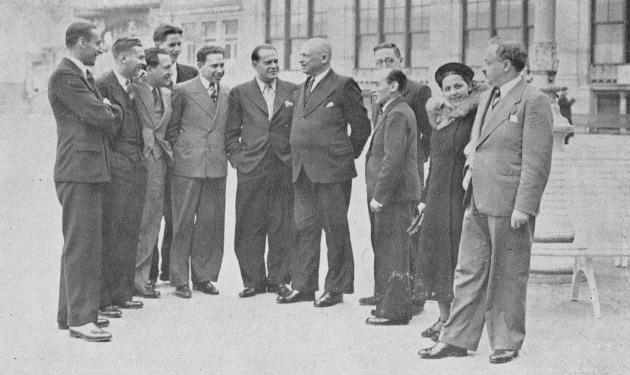
Left to right: H.
Grob, R. Fine, G. Koltanowski, P. Keres, A.
Dunkelblum,
S. Landau, S. Tartakower, A. Reynolds (behind), I.
Dyner, Mrs List, P. List
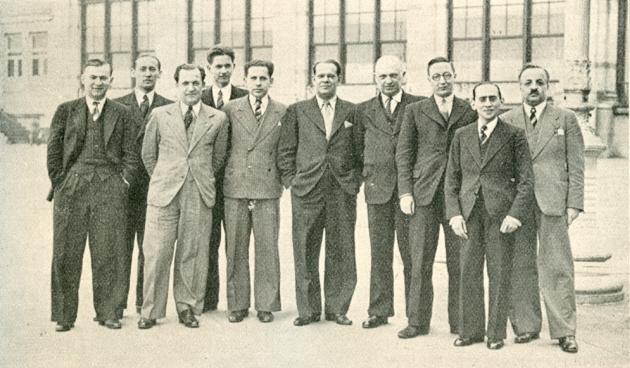
Left to right: R.
Fine, H. Grob, G. Koltanowski, P. Keres, A.
Dunkelblum,
S. Landau, S. Tartakower, A. Reynolds, I. Dyner, P.
List
An individual portrait of Reynolds was published on page 282 of CHESS, 14 April 1939, accompanying the article ‘Meran Defence Crack Exposed’ (see C.N. 4635):
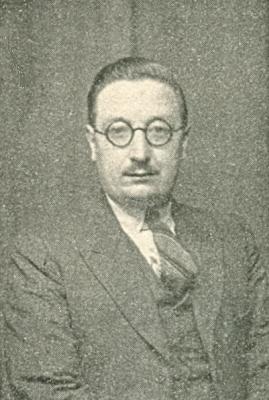
Arthur Reynolds
This picture was also given in Olimpiu G. Urcan’s
book on E.E. Colman, Surviving Changi
(Singapore, 2007). See pages 154-155 for some
information about Reynolds’ demise in the Far East.
Another source is the Quotes & Queries item 4023
(mainly written by W. Ritson Morry) on pages 150-152
of the March 1980 BCM.
Reynolds’ death was mentioned on pages 193 and 198 of CHESS, September 1944, but not in the BCM at the time. CHESS reported that he had ‘died a prisoner in the hands of the Japanese’. The above-mentioned article by Ritson Morry stated that Reynolds was killed on board a Japanese prison ship which was torpedoed by a US submarine.
6070. Campbell-Bannerman
Wanted: a proper source for an observation commonly attributed to Sir Henry Campbell-Bannerman (1836-1908): ‘Chess is not a game but a disease.’
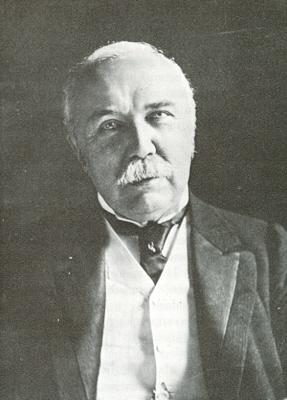
Sir Henry Campbell-Bannerman
The above photograph appeared on page 132 of A Prime Minister on Prime Ministers by Harold Wilson (London, 1977).
6071. Lasker on Capablanca
In an item written in Havana on 30 April 1921 Lasker commented regarding Capablanca:
‘Aus seinen Zügen liest sich sein Gedanke ab, selbst da, wo er listig sein will. Ob er auf Remis oder Gewinn spielt oder zu verlieren fürchtet, sein Zug verkündet laut, was er fühlt. Bei alledem sind seine Züge, wiewohl durchsichtig, keineswegs naheliegend, und oft tief.’
Source: page 30 of Lasker’s booklet Mein Wettkampf mit Capablanca (Berlin and Leipzig, 1926).
We are grateful to Ralf Binnewirtz (Meerbusch, Germany) and Richard Forster (Zurich, Switzerland) for pointing out a mistranslation on page 111 of our book on Capablanca. The various meanings of the German word Züge, which Lasker used three times, include (a) facial features and (b) moves (in chess) – quite apart from (c) trains. From the way the passage begins, (a) would seem a plausible interpretation, but our correspondents inform us that (b) is the meaning throughout.
A revised translation therefore reads:
‘From his moves you can read his thoughts, even when he is trying to deceive you. Whether he is playing for a draw or a win, or is afraid of losing, his move proclaims aloud what he feels. For all that, his moves, although transparent, are by no means obvious and are often deep.’
6072. A famous remark (C.N. 6060)
Concerning the remark ascribed to Ely Culbertson ‘There is no other game so esteemed, so profound and so venerable as chess; in the realm of play it stands alone in dignity’, Oliver Beck (Seattle, WA, USA) notes that a condensed version appeared on page 1 of The Personality of Chess by I.A. Horowitz and P.L. Rothenberg (New York, 1963):
‘In the realm of play, chess stands alone in dignity – Geoffrey Mott-Smith.’
No source was given. We add that in Rothenberg’s obituary of Mott-Smith on pages 302-303 of the October 1960 Chess Review it was stated that the quote in Culbertson’s Hoyle was written by Mott-Smith:
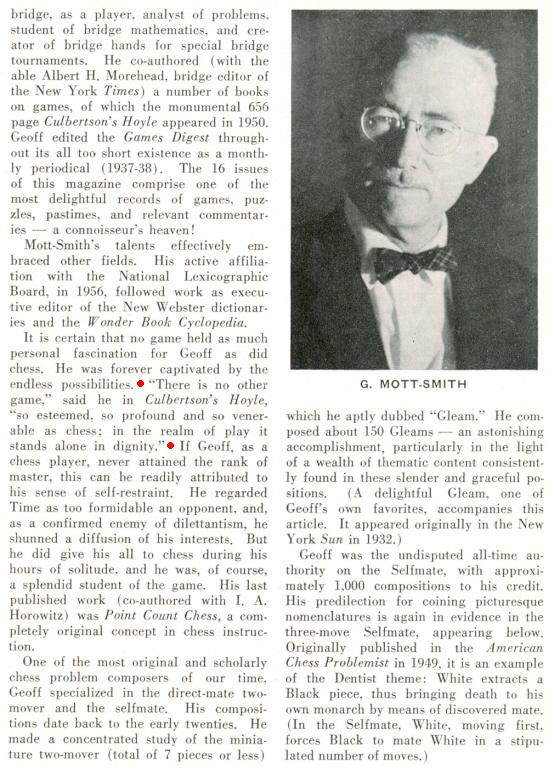
Extract from page 302 of Chess Review, October 1960
The grounds for attributing the quote to Culbertson are thus evaporating.
Mott-Smith brought out an edition of Hoyle’s Rules, jointly with Albert H. Morehead, in 1946, four years before the edition which carried Culbertson’s name (and which, as mentioned in C.N. 6060, was co-edited by Morehead and Mott-Smith). Did the quote under discussion also appear in the 1946 volume?
6073. Quincy A. Brackett (C.N. 2991)
Further to C.N. 2991 (see page 177 of Chess Facts and Fables), we are still seeking clarification as to whether Q.A. Brackett, a rival of Capablanca’s during their student years, was the son of John Quincy Adams Brackett (1842-1918), the one-time Governor of Massachusetts.

J.R. Capablanca
(Columbia) in play against Q.A. Brackett (Harvard),
New York, 20 December 1906
The best example of Brackett’s play that we have found comes from page 6 of the January 1906 American Chess Bulletin:
Quincy A. Brackett (Harvard) – Charles Williams (Princeton)New York, 23 December 1905
Giuoco Piano
1 e4 e5 2 Nf3 Nc6 3 Bc4 Bc5 4 c3 Nf6 5 d3 d6 6 O-O O-O 7 Be3 Bxe3 8 fxe3 Bg4 9 Nbd2 Ne7 10 Qe1 c6 11 Qg3 Ng6 12 Bb3 Qd7 13 h3 Bxf3 14 Nxf3 Rab8 15 Nh4 Kh8 16 Nf5 Ng8 17 h4 h5 18 Qg5 Nf6

19 Nxg7 Nh7 20 Qf5 Qxf5 21 Nxf5 Rbd8 22 Nh6 Rd7 23 Rxf7 Rdxf7 24 Nxf7+ Kg7 25 Nxd6 Rd8 26 Nf5+ Kf6 27 d4 exd4 28 exd4 Re8 29 Rf1 b6 30 e5+ Nxe5 31 dxe5+ Rxe5 32 Nd4+ Kg7 33 Nxc6 Re2 34 Rf2 Re1+ 35 Kh2 Nf6 36 Rd2 Re3 37 Bd1 a6 38 Nb4 a5 39 Nd5 Re4 40 Nxf6 Kxf6 41 g3 Re5 42 Rd6+ Kf5 43 Rxb6 Ke4 44 c4 Kd4 45 Rb5 Re1 46 Bxh5 Kxc4 47 Rxa5 Kb4 48 Rf5 Ra1 49 Rf4+ Kc5 50 Bf7 Resigns.

Q.A. Brackett
6074. IQP
‘The isolated queen’s pawn is an important learning element in chess strategy. The late Bob Wade first coined the term IQP in his 1963 book on the World Championship match between Botvinnik and Petrosian.’
Source: Raymond Keene, in his chess column in The Times, 11 April 2009.
With Google Books it takes about ten seconds to find earlier occurrences of ‘IQP’, one instance being in The Return of Alekhine by C.J.S. Purdy (Sydney, 1938). We add that the text in question, concerning the nineteenth match-game between Euwe and Alekhine, had already appeared on page 349 of Purdy’s Australasian Chess Review, 20 December 1937:
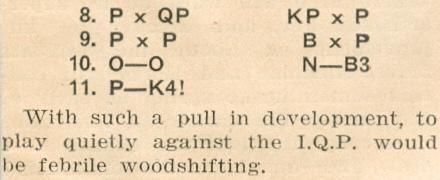
For our part, we would never claim that even Purdy ‘first coined the term IQP’ (or that it was only in 1937 that he first used it).
6075. Arthur Reynolds (C.N. 6069)
From Olimpiu G. Urcan (Singapore):
‘The War Graves Photographic Project gives details regarding Arthur Reynolds, who died on the Suez Maru, a Japanese cargo ship sunk on 29 November 1943. His name appears on a website providing an account of the event.
On 11 April 2009 I went to the Kranji War Cemetery, where the Singapore Memorial is located, and took a number of photographs, including the following:
Research has enabled me to gather a considerable amount of additional information about Reynolds’ final months, and it has been forwarded to your correspondent, Tony Quint.’
6076. Bell v Donaldson
From Rod Edwards (Victoria, BC, Canada):
‘In the 24 July 1847 Illustrated London News (page 59) Staunton gave the result of “a little match of five games played at the commencement of this year, between Captain J.G. Bell, of Cunoubie [sic – Canonbie], and Mr D. (Delta), the best player in the Dumfries Chess Club”. The score was Delta 2 Bell 3, and a win by Delta was presented. “Delta” was a sobriquet for the Reverend John Donaldson (1817-92).
The moves (with Bell as White) were: 1 g3 e5 2 Bg2 d5 3 b3 c5 4 d3 Nc6 5 c4 d4 6 Bxc6+ bxc6 7 e4 Nf6 8 f4 exf4 9 Bxf4 Ng4 10 Nf3 Bd6 11 e5 Qe7 12 O-O Bc7 13 Re1 Be6 14 Qe2 h6 15 Qe4 Qd7 16 Na3 g5 17 Bd2 O-O-O 18 Qe2 Rhe8 19 h3 Ne3 20 g4 f5 21 exf6 Bxg4 22 Bxe3 Rxe3 23 Qg2 Bxf3 24 Qf2 Qxh3 25 White resigns.
However, in the 17 July 1847 issue of the Chess Player’s Chronicle (page 226) Staunton said that he had received “several interesting parties lately played by Mr Donaldson, the well-known victor in the London and Edinburgh match by correspondence, many years ago”. This, of course, refers to James Donaldson, whose death was reported in the February 1848 Chess Player’s Chronicle (page 61). On pages 240-241 of the 31 July 1847 issue of the magazine Staunton again identified the player as the older Donaldson, and gave three games, two of them against Captain J.G. Bell (one win each). A third game against Bell appeared on page 250 of the 7 August 1847 issue (won by Bell), and a fourth game (drawn) was on pages 48-50 of the February 1848 issue. This last game was dated June 1847 in the notice of Donaldson’s death on page 61, and so it, at least, was not played “at the commencement of this year”. The game in the Illustrated London News was not one of those printed in the Chess Player’s Chronicle.
Thus, Staunton identified the opponent of Captain J.G. Bell as the younger Donaldson in the Illustrated London News but as the older Donaldson in the Chess Player’s Chronicle. Which of the two Donaldsons was it, or did they both play games against Bell that year?’
Below we can merely make a start on trying to unravel a particularly complex matter. In an article entitled ‘Delta’s Reminiscences’ on pages 450-459 of the October 1891 BCM John Donaldson wrote:
‘From 1838 to 1841 I played very little chess, as I was travelling and studying art in Italy and Germany. Upon my return home, in 1841, I played a few games at Canonbie Manse with an Indian amateur, a strong player, Captain J.G. Bell, at one particular variation of the Muzio Gambit, in which he sacrificed a second piece and won often even then by force of position and pawns. One or two of these games are, I think, given in the 1842 year of the Chess Player’s Chronicle, edited by Howard Staunton. I have not beside me that 1842 volume. It was through Bell and his Bello Gambit, as I called it, that I became acquainted with Staunton and began a correspondence with him, and sending games to the Illustrated London News, which he then edited, has been continued ever since up to this present year [sic].’
Also on page 451, John Donaldson referred to ‘Bailie [James] Donaldson, facile princeps the greatest player whom Scotland has yet produced’. He added, with respect to 1846: ‘But the Bailie played then in his old age at least a pawn and move below what he was at his best, when he beat London at the great correspondence match. I played in all, in 1846, five games with the Bailie, of which I won two and lost three.’
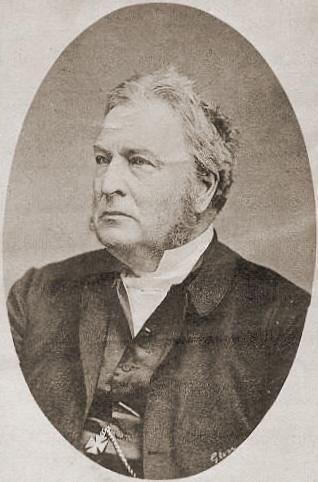
John Donaldson
(frontispiece, October 1891 BCM)
A letter from James White of Leeds on page 511 of the November 1891 BCM confused the two Donaldsons, and this resulted in a correction by ‘Delta’ on pages 531-533 of the December 1891 issue.
The Bello Gambit (1 e4 e5 2 f4 exf4 3 Nf3 g5 4 Bc4 g4 5 O-O gxf3 6 Qxf3 Qf6 7 Nc3) was discussed on pages 242-243 of the 1844 volume of the Chess Player’s Chronicle, introduced as follows:
‘A number of cleverly played games at this opening have just reached us, all turning on the sacrifice of the king’s bishop as well as the knight, a variation lately struck out by Captain J.G. Bell, a skilful amateur of North Britain, who has successfully adopted it against a host of competitors.’
An illustrative win by Bell was given, against an unnamed opponent.
The same opening occurred in one of the games mentioned above, i.e. on pages 240-241 of the 1847 Chess Player’s Chronicle. Bell defeated Donaldson (James, according to the Chronicle).
Since the Chronicle stated that the Captain played the Bello Gambit against ‘a host of competitors’, they may well have included both Donaldsons. It thus seems quite possible that Staunton identified the correct Donaldson on each occasion, and also that John Donaldson recorded certain dates inaccurately in his BCM reminiscences. At present, though, we feel sure about very little in this matter.
6077. No mistakes
Wanted: contemporary substantiation of a remark supposedly made by Lasker to Capablanca:
‘A week or so earlier [compared to 26 July 1914] these two masters had met in Berlin, where they played a rapid-transit match of ten games. Capablanca won 6½:3½, and afterwards Lasker is alleged to have said, “It is remarkable: you make no mistakes”.’
Source: The Unknown Capablanca by David Hooper and Dale Brandreth (London, 1975), page 168.
Irving Chernev gave the words as ‘It is remarkable; you never seem to make a mistake’ in Chess Review, April 1954 (inside front cover and page 125) and as ‘Young man, you play remarkable chess! You never make a mistake!’ on page 234 of Combinations The Heart of Chess (New York, 1960).
6078. Who?
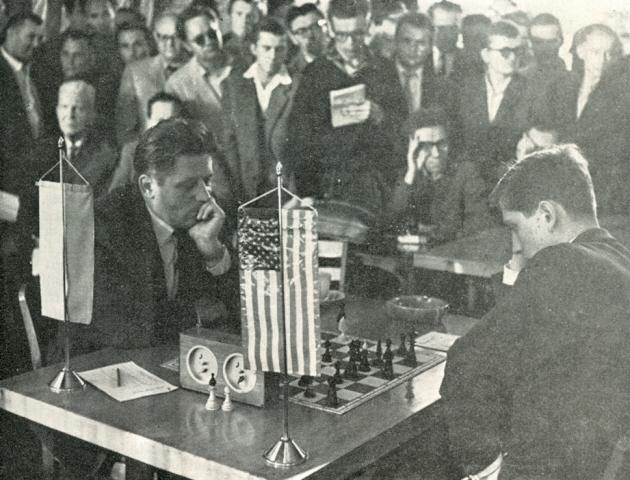
Who is Fischer’s opponent?
6079. Schulten v Morphy
John Blackstone (Las Vegas, NV, USA) asks for a reliable contemporary version of the moves of a game between Schulten and Morphy, New York, 1857. We reproduce below (without the notes) the score as it appeared on page 21 of the Chess Monthly, January 1858:
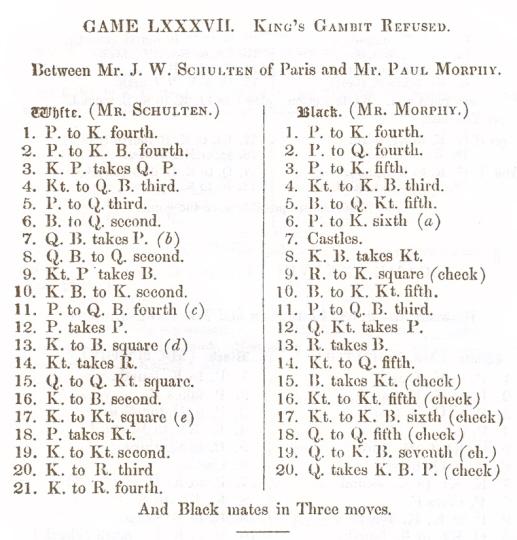
Schulten’s encounters with Morphy in late 1857 (he scored +1 –23 =0) were referred to on pages 30-31 of the same issue of the Chess Monthly. Contrary to occasional claims made even today, there was no suggestion in the magazine that Morphy played any of the games blindfold.
6080. A famous remark (C.N.s 6060 & 6072)
A copy of The Penguin Hoyle by Albert H. Morehead and Geoffrey Mott-Smith (New York, 1946) is now to hand. The chess section (pages 196-205) does not contain the quote under discussion.
The back cover provides some biographical information about the co-authors:
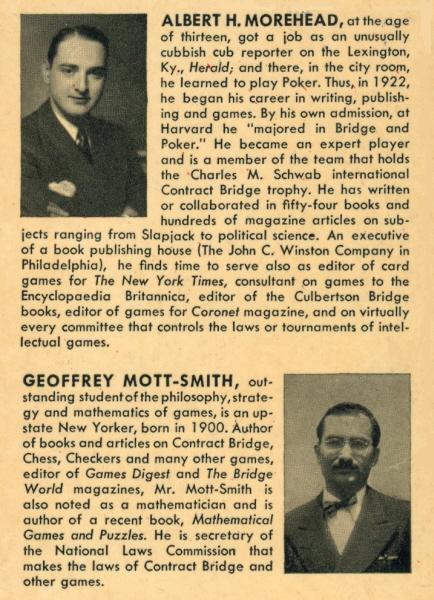
6081. Sir Clement Freud (1924-2009)
Following the death of Sir Clement Freud on 15 April 2009, we reproduce a photograph from page 121 of CHESS, January 1973:
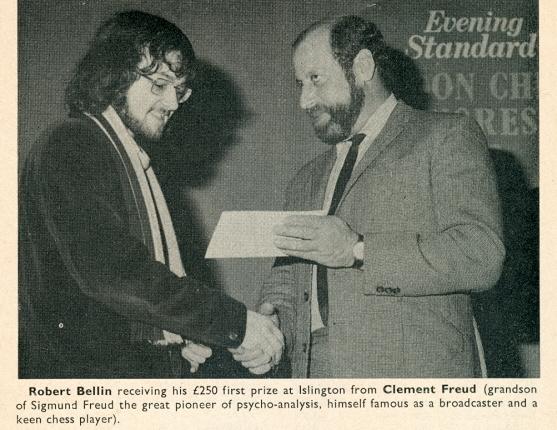
6082. Dreizügegesetz (C.N. 6066)
João Pedro S. Mendonça Correia (Lisbon) quotes from page 217 of The Game of Chess by Siegbert Tarrasch (London, 1935):
‘We must not imagine, however, that we can attack wherever we wish. In chess, to play correctly, we can never do what we wish, we must do only what we are forced to do, what the position demands. Positional play, that is to say, playing according to the position, is the only correct method, and from it combinations result of themselves. We must attack where we are strong and our opponent weak. We should always attempt to occupy the strong points in our own and the weak points in our opponent’s game, at the same time striving to prevent the occupation of such points by our opponent. Each position must be regarded as a problem, where it is a question of finding the correct move, almost always only one, demanded by that position. In a game of chess secondary solutions are almost non-existent, except in the first moves of the opening where there is freedom of choice.’
It is the penultimate sentence which is particularly relevant to our theme. The original text, on page 306 of Das Schachspiel (Berlin, 1931), reads:
‘Jede Stellung muß man als ein Problem betrachten, bei dem es gilt, den richtigen Zug, den die Stellung erfordert und der fast immer ein einziger ist, zu finden.’
Wanted: earlier occurrences of such sentiments in Tarrasch’s writings.
6083. Janowsky
v Reshevsky
The article by Irving Chernev
on the inside front cover of the April 1954 Chess
Review (C.N. 6077) included 15 alleged quotes,
none with sources. One was: ‘That boy understands as
much of chess as I do of rope dancing.’ Page 125
mentioned that the speaker was ‘Janowsky, referring to
his game with the prodigy Reshevsky’. The complete
feature was reproduced on page 271 of Chernev’s The
Chess Companion (New York, 1968).
On page 243 of Chess Secrets I Learned from the Masters by Edward Lasker (New York, 1951) it was reported that Janowsky had made the remark to Lasker after 12 moves of the game Janowsky v Reshevsky, New York, 1922. It was a famous victory for the ten-year-old prodigy, and the following appeared on page 18 of Reshevsky on Chess (New York, 1948):
‘I was so excited and happy that I rushed home in a taxi to tell my father and mother. I couldn’t even sit down in the taxi. I jumped up and down all the way. When I got to the hotel, I ran up the stairs to our rooms, without waiting for the elevator, and broke the news to my parents: I had won from Janowsky! And then I sang. I sang so loudly that nobody could talk. It was one of the happiest days of my life.’
In Edward Lasker’s version (pages 247-248 of Chess Secrets) the prodigy’s father was in the taxi. The report on page 28 of the Sports Section of the New York Times, 13 October 1922 stated:
‘After 65 moves had been recorded, Janowsky, seeing his pawns falling one by one, resigned and was the first to offer his congratulations to the boy.’
This photograph was given on page 158 of the November 1922 American Chess Bulletin:
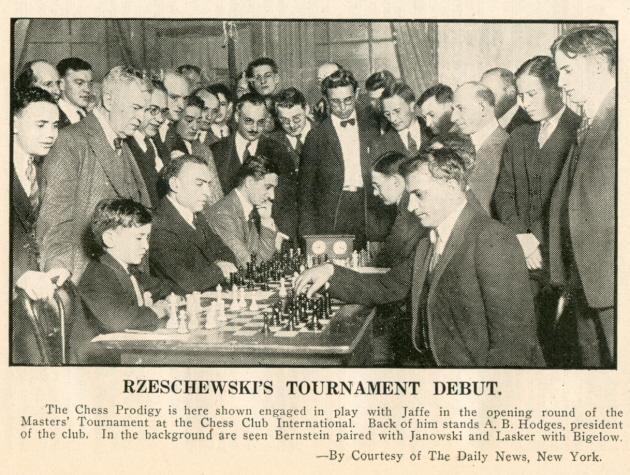
The tournament received a brief mention on pages 193-194 of A History of Chess by H. Golombek (London, 1976). Reshevsky’s final score and his placing were incorrect, as were Bigelow’s. Jacob Bernstein was misidentified as ‘S. Bernstein’, and the index reference to Jaffe gave his forename as Oscar, instead of Charles.
6084. Who? (C.N. 6078)

Many readers correctly responded that Fischer’s opponent was Bogdan Sliwa. The photograph was published on page 241 of the November 1962 Chess Life, the occasion being a small United States v Poland team match in Warsaw, shortly before the Olympiad in Varna.
6085. Cotlar (C.N.s 3581, 3584, 3613 & 3665)
Christian Sánchez (Rosario, Argentina) sends this photograph of Ovsey Cotlar, which appeared in the television programme Laboratorio de ideas on the Encuentro channel (an interview with his son, the mathematician Mischa Cotlar).

Ovsey Cotlar
6086. J’adoube (C.N. 5485)
Confirming that ‘compongo’ is indeed the term used by most Spanish players when they wish to adjust a piece on the board, Pablo S. Domínguez (Madrid) quotes from Article 4.2 of FIDE’s Laws of Chess as published by the Spanish Chess Federation:
‘El jugador que está en juego puede ajustar una o más piezas en sus casillas, siempre que previamente exprese su intención de hacerlo (por ejemplo, diciendo “compongo”).’
The English text reads:
‘Provided that he first expresses his intention (e.g. by saying “j’adoube” or “I adjust”), the player having the move may adjust one or more pieces on their squares.’
Mr Domínguez notes that some players prefer ‘acomodo’ to ‘compongo’. He adds that the verb componer in this sense dates back to at least the time of Ruy López, as is shown by this paragraph from page 65 of Libro de la invención liberal y arte del juego del axedrez (Alcalá, 1561):
‘La.3. ſea, Que ſepa que todo jugador es obligado à jugar dela pieça que tocare, ſi el tocar no fuere por cauſa de componella, y cócertalla: con tal que lo diga enderezco te, ò corrigo te, ò otra coſa ſemejáte: no paſſando mora en ello. Porque ſi entreuiniere tardança, ſea viſto auer querido jugar della, y auer ſe arrempentido por no le pareſcer bien: y por aqueſto juegue della.’
Translation by Mr Domínguez:
‘The 3rd [rule] being that the player is obliged to move the piece which he has touched, unless, in touching it, he intended only to adjust and arrange it. In that case he must say “I straighten you”or “I correct you”, or a similar thing, without delay. For, if he took time to say it, this might be seen as if he intended to move the piece and later regretted his decision, judging it a bad one; thus, he should move it.’
6087. Quincy A. Brackett (C.N.s 2991 & 6073)
Russell Miller (Camas, WA, USA) informs us that the Draft Registration Card for Quincy Adams Brackett states that he was born on 7 July 1885. This matches up with the obituary on page 17 of the New York Times, 13 August 1951, which reported that he had died at the age of 66 (see C.N. 2991).
As to whether he was the son of the Governor of Massachusetts, John Quincy Adams Brackett (1842-1918), Nikolai Brunni (Honolulu, HI, USA) demonstrates that such was not the case. He has sent us pages 224-226 of American Biography: A New Cyclopedia by William Richard Cutter (New York, 1919). This shows that there was another John Quincy Adams Brackett (1840-1918), a Boston businessman. An extract from his entry:
‘In many respects he resembled the late ex-Governor John Quincy Adams Brackett, and though a close personal friend of the former governor was not related, but the similarity in the names often occasioned amusing experiences for both.’
By his second marriage ‘there was one son, Quincy Adams, now living in Pittsburgh, Pennsylvania, where he is connected with the Westinghouse Electric Company’.
The Westinghouse enterprise was referred to in the above-mentioned New York Times obituary of the chessplaying Brackett.
6088. Missing
word quiz question
According to a chess book published in the United States, the term for ‘the foremost pawn(s) of a salient or reverse salient’ is a ___.
6089. Śliwa v Fischer (C.N. 6084)
Dan Scoones (Port Coquitlam, BC, Canada) draws attention to a second photograph taken during the game Śliwa v Fischer, Warsaw, 1962: U1347491 at the Corbis website.
6090. Reuben Fine and psychoanalysis (C.N. 5238)
We now note that the familiar comment about Reuben Fine was made by Gilbert Cant in an article ‘Why They Play: The Psychology of Chess’ on pages 44-45 of Time, 4 September 1972:
‘When Fine switched his major interest from chess to psychoanalysis, the result was a loss for chess – and a draw, at best, for psychoanalysis.’
The full article can be read online via the link to Time given in C.N. 5819.
6091. Fine and the 1948 world championship

Reuben Fine
A number of C.N. items (see pages 262-263 of Chess Facts and Fables) have discussed why Reuben Fine did not participate in the 1948 world championship match-tournament. For ease of reference, we reproduce here the summary of Fine’s own versions, provided in an article we wrote for ChessBase in 2007:
In C.N.s 1680 and 1915 Edward J. Tassinari (Scarsdale, NY, USA) quoted various, and varying, explanations by Reuben Fine of his absence from the 1948 world championship match-tournament:
On page 2 of the November 1948 Chess Review Fine wrote:
‘At the time of the tournament, I was not teaching, but working on my doctoral dissertation. I was not bound by any contract to the university. I withdrew from the tournament because I did not care to interrupt my research. Needless to say, nobody had consulted me on whether the dates set were convenient for me.’
From pages 151-152 of Lessons from My Games by Reuben Fine (New York, 1958):
‘The next year they [presumably the Russians] changed their minds again, and the tournament was held. By that time I was embarked on my new profession as a psychoanalyst and was unable to play.’
Pages 4-5 of Bobby Fischer’s Conquest of the World’s Chess Championship by ‘Reuben Fine, Ph.D., International Chess Champion’ (New York, 1973) claimed that a proposed 1947 tournament for the title was ...
‘… called off by the Russians as part of a kind of blackmail scheme to force the players to compete in Russia. My own refusal to play in 1948 was motivated in part by the uncertainty about whether the Russians would come to the playing hall at all, and if so, under what conditions.’
On page 11 of that book Fine related that by the time the 1948 match-tournament was arranged ...
‘... I was absorbed in another profession, psychology, and no longer cared to participate.’
In an interview with Bruce Pandolfini on page 25 of Chess Life, October 1984 (‘Reuben Fine: The Man Who Might Have Been King’) Fine stated that he decided not to compete in the 1948 championship because if he had gone to the Netherlands (the site of the first part of the event) the Russians might not have participated and he would have wasted ‘a whole year of his life in preparation. Moreover, it seemed foolish to play in such hostile circumstances.’
Next, an extract from a Fine letter on page 7 of the September 1989 Chess Life:
‘The tournament was finally arranged for 1948, to be played half in the Netherlands and half in the Soviet Union (where the safety of the foreign masters was questionable). I did not play because of the expense involved, most of which I was expected to pay myself; and because I considered the tournament as it was arranged to be illegal. TASS fabricated a story that I had had to desist because of career pressures. (In fact, I was not at that time employed; I was working on my doctorate.) The TASS story was a total fraud.’
Page 4 of the February 1948 Chess Review stated that the magazine had received a telegram from Fine: ‘Professional duties make it impossible for me to get away in time to play in the tournament.’
We add that page 158 of The Encyclopaedia of Chess by Anne Sunnucks (London, 1976) stated that Fine ‘refused the invitation because a training match against Steiner had proved that he was out of form’. Did Fine ever make such a claim?
From page 4 of Chess Review, December 1947:
‘California. Drawing the final game in the series, Reuben Fine won his match against Herman Steiner 5-1. Both players played erratic chess.’
6092. Fischer and Hastings
Graeme Cree (Austin, TX, USA) raises the subject of Fischer’s participation in the 1957-58 US championship in New York (which was a Zonal tournament), rather than the concurrent Hastings tournament. He points out an article by Montgomery Major on page 4 of the 5 November 1957 Chess Life which praised Fischer for deciding not to play in the championship, given that he had already accepted an invitation to Hastings:

Mr Cree adds that an article by Bernard Taper in The New Yorker of 7 September 1957 (pages 25-27) also stated that Fischer would be playing in Hastings. Our correspondent comments:
‘So, according to these two sources the result which first brought Fischer to world prominence almost never happened at all. The 20 November 1957 Chess Life (pages 1 and 3) announced him as one of the participants in the US championship, with no explanation or even acknowledgement of the change. What happened?’
See also page 19 of Profile of a Prodigy by Frank Brady (New York, 1973), but the detailed sequence of events is not yet clear to us. ‘Brooklyn Boy Is Invited To Play Chess Masters’ was the headline of a brief news story about the Hastings tournament on page 45 of the Sports Section of the New York Times, 11 June 1957. Page 155 of the June 1957 BCM stated that ‘according to press reports young Bobbie Fisher, of New York, has been invited to play’. His name was spelt correctly on page 266 of the October 1957 issue, which reported that an invitation to play in Hastings had been accepted by ‘Bobby Fischer, who at the age of 14 has just won the US Open’ (in August). Fischer was again in the list of expected participants at Hastings on page 286 of the November 1957 BCM. His withdrawal was mentioned, without elucidation, by Wolfgang Heidenfeld on page 29 of the February 1958 BCM.
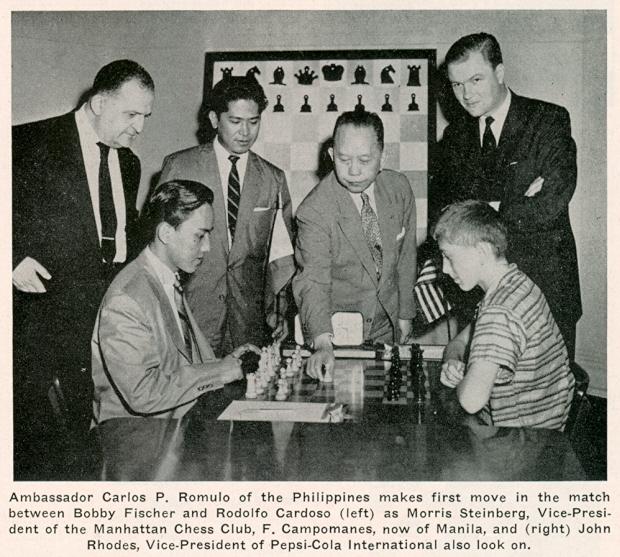
Source: Chess Review, November 1957, page 322
6093. Pion coiffé
From Dominique Thimognier (St Cyr sur Loire, France) comes this game on page 211 of Le Sphinx Journal des Echecs, 1866:
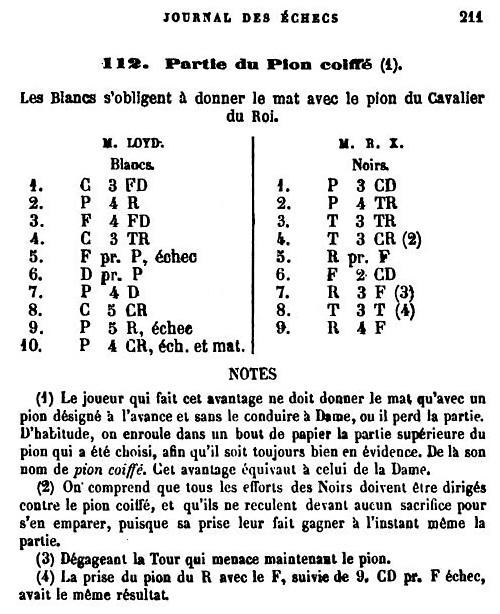
1 Nc3 b6 2 e4 h5 3 Bc4 Rh6 4 Nh3 Rg6 5 Bxf7+ Kxf7 6
Qxh5 Bb7 7 d4 Kf6 8 Ng5 Rh6 9 e5+ Kf5 10 g4 mate.
Information on the identity of the players is sought.
Michael McDowell (Westcliff-on-sea, England) notes that page 458 of Sam Loyd and His Chess Problems (Leeds, 1913) had the conclusion of a capped-pawn game between the Loyd brothers. Below is the full score, from pages 207-208 of the Chess Monthly, June 1857:
Thomas Loyd – Samuel LoydOccasion?
(White’s g-pawn is capped)
Queen’s Pawn Game
1 d4 d5 2 Nc3 Nc6 3 Bf4 Nf6 4 a3 Bf5 5 e3 e6 6 Bd3 Ne7 7 Nb5 Bxd3 8 Nxc7+ Kd7 9 cxd3 Ng6 10 Qa4+ Kc8 11 Rc1 Nh4 12 Nxe6+ Qc7 13 Rxc7+ Kb8
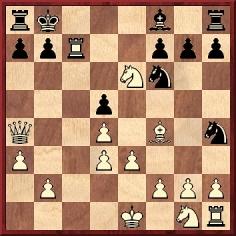
14 Rxf7+ Kc8 15 Rc7+ Kb8 16 Rxg7+ Kc8 17 Rc7+ Kb8 18 Rxh7+ Kc8 19 Rxh4 Rxh4 20 Nxf8 Kd8 21 Be5 Nh7 22 Nxh7 Rxh7 23 Bd6 Rc8 24 Qb5 Rh5 25 Qxb7 Rxh2 26 Rxh2 Rc1+ 27 Kd2 Rxg1 and White gave mate in 11 moves.
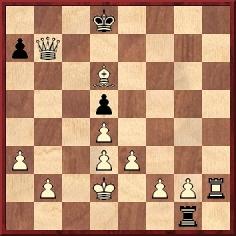
This is the position in the above-mentioned Loyd book, which (whilst noting that ‘there are many duals and short mates in the variations’) gave the following as a mate in 11: 28 Qc7+ Ke8 29 Qc8+ Kf7 30 Rh7+ Kf6 31 Be5+ Kg5 32 Qg8+ Kf5 33 e4+ dxe4 34 Qf7+ Kg4 35 Qe6+ Kg5 36 f4+ exf3 37 Qf6+ Kg4 38 gxf3 mate.
6094. Who?
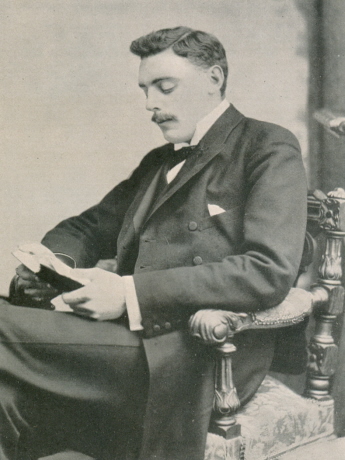
6095. The Golden Girls
The US actress Beatrice Arthur, who died on 25 April 2009, starred in NBC’s The Golden Girls (1985-92), one of the most successful of all situation comedies. Two episodes had scenes featuring a game of chess: ‘There Goes the Bride’ (part one) and ‘Henny Penny – Straight, No Chaser’.
6096. Missing word quiz question (C.N. 6088)
The term for ‘the foremost pawn(s) of a salient or reverse salient’ is ‘van’, according to page 340 of Point Count Chess by I.A. Horowitz and Geoffrey Mott-Smith (New York, 1960). A ‘salient’ was defined on the previous page as ‘a formation of three pawns in a “V” pointing away from the owner, as white pawns on QB4, Q5 , K4’. Another uncommon word on page 339 was ‘subcenter’, defined as follows: ‘the squares immediately adjacent to the center, particularly those on the fourth and fifth ranks’.
6097. Fischer and Hastings (C.N. 6092)
From Leonard Barden (London), who was a participant in the tournament in question (Hastings, 1957-58):
‘I have the impression that Fischer withdrew in late October, which, allowing for magazine production time, would be consistent with the Chess Life and BCM reports. Given that FIDE had a four-year cycle and that Fischer obviously had a chance to qualify for the Interzonal, I do not think that any other decision by him was possible. Frank Rhoden, the Hastings organizer, was philosophical about it, and hoped to include Fischer another year. A couple of weeks before the start of the tournament, Rossolimo also withdrew, giving an opportunity to me.’
We add that the top finishers at Hastings, 1957-58 were: 1st P. Keres; 2nd S. Gligorić; 3rd M. Filip; 4th L. Barden.
6098. Bondarevsky v Ufimtsev (C.N.s 2989, 2995, 4272 & 4280)

White to move
In this game, played in Leningrad in 1936, White won with 1 Rh8+ Kf7 2 Be8+ Nxe8 3 Kg5 and 4 Rf8. The full score has still not been found, but it is surprising to see the above position on page 300 of Forcing Chess Moves by Charles Hertan (Alkmaar, 2008) with the players’ names inverted and the occasion given as ‘Soviet Union 1940’.
Below we reproduce the source referred to in C.N. 4272, i.e. page 30 of Bondarevsky’s Kombinacii v mittel’spile (Moscow, 1965):
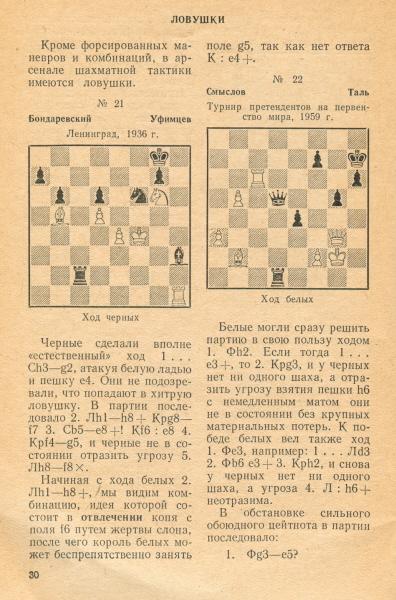
In Forcing Chess Moves the Abrahams and Ahues positions on page 143 and page 271 are also misdated, the latter by over 30 years; see, respectively, pages 278-279 of Chess Facts and Fables and C.N. 3918. Such errors are, though, very scarce, and Hertan has produced a particularly interesting book which avoids the beaten track.
6099. Two directors
Christian Sánchez (Rosario, Argentina) sends a cutting from page 14 of La Capital, 7 November 1930:
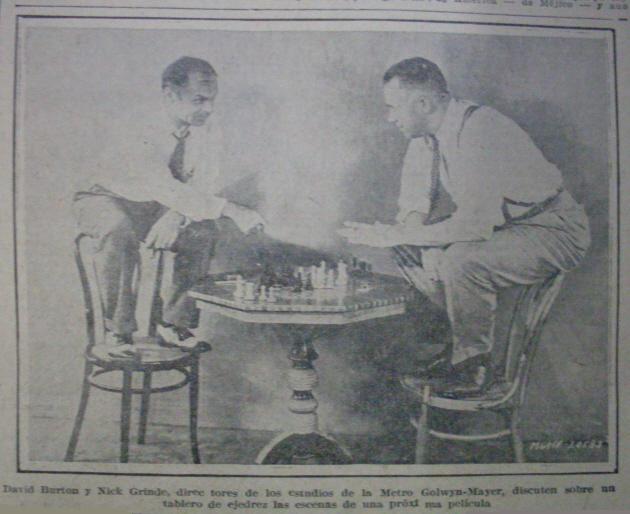
The caption states that two Metro-Goldwyn-Mayer directors, David Burton and Nick Grinde, are discussing scenes from a film. We note that the two men co-directed the 1930 production The Bishop Murder Case (see C.N. 5948).
| First column | << previous | Archives [57] | next >> | Current column |
Copyright: Edward Winter. All rights reserved.
